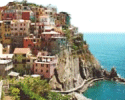
We're an all volunteer website and need your help to keep going. Here are five ways you can contribute: 1 Donate 2 Buy something 3 Submit a story 4 Volunteer 5 Advertise

New in the gift shop, virtualitalia.com logo wear and use items! 
|
PLEASE NOTE: We are experiencing unexpected
technical difficulties caused by our web host. We apologize for
the inconvenience. During your visit you may experience service
and page interruptions - we are in the process of fixing everything and hope to be
fully back on our feet soon.
genoa lost & found Sounds of clinking silverware and lunchtime conversations drifted into the alley through dark green shutters of second story windows. Up ahead a pair of sculpted cupids floated above a pastry shop. I slowed down to inhale the sweet smell of baking. A church bell rang as a woman approached me, �Scusi, signora, dove �� I stopped her before she could ask directions. In my shoddy Italian I explained with a smile that I was lost too. She smiled back and I went on my way, meandering through the shadowy paths of the historic center of Genoa. Most of the time getting lost in Italy brings on grimaces rather than smiles � as in my many memories of �Can this marriage survive whose fault is it we took the wrong exit off the autostrada� moments. But getting lost in the maze of narrow medieval streets in Genoa�s Centro Storico could not have been more idyllic. The area, squeezed between the port and the city�s terraced hillside, is said to be the largest historical center in Europe. Last April, I tucked away my impossible-to-follow map and discovered that surrendering to Genoa, letting her reveal herself on her own terms, was the way to find the essence of this city of grand and humble treasures. Upon arrival, my group�s guide, Michela (a flaming red-haired 20-something part time pop music singer), was enthusiastic about introducing us to Genoa�s high profile sights � the port and palaces which surround the historic area. Genoa has been named a European Cultural Capital of 2004, and everywhere banners announced special museum exhibits and performance events. Locals like Michela were pumped to show off Genoa, La Superba (The Haughty) � the nickname it took on during its 13th to 18th century maritime heyday. I found myself most attracted by Genoa the Humble. Michela started us off at the Porto Antico, redeveloped in 1992, when Genoa celebrated the 500th anniversary of the voyage of its most famous native, Christopher Columbus. I drifted from the modern Lorenzo Piano designed structures to the folksy food stalls. There, under a cluster of sunflower-colored tents, cooks sold regional specialties and I spotted what was to become my favorite Genovese snack: thin lightly salted focaccia bread served hot and stuffed with melted cheese. A short drive away from the Porto Antico, we found a more tranquil experience of Genoa�s 19-mile coastline in Boccadasse, an ancient fishing village near the city�s border. Euphoria set in as I ate vanilla gelato studded with pralines, and lazed up and down the winding stone waterfront path. The sparkling Mediterranean perfectly complemented a circle of life scene; Mammas dipping their babies in the sea, kids racing by holding farinata wrapped in paper (a traditional chickpea crepe snack), teenagers sunning themselves on the black pebbled beach, brides in flowing gowns posing for photographs, and elderly men in dark suits proceeding slowly with wooden canes. Our home base (the Starhotel President) was in the modern area of town, a short walk to the Via Settembre XX, a 19th century grand boulevard flanked by a sculpted arcade which serves as entrances to chain stores and designer shops. Once again, I was drawn off the major thoroughfare to discover a treasure: the Mercato Orientale. This old market was an Augustinian monastery and now a daily stop for housewives to pick up the catch of the day and the harvest of the season (including mounds of white asparagus), and housewares. The most unforgettable sight and smell in the market came from overflowing piles of basil. The leaves were smaller and a more vibrant green than I�ve ever seen on the plants before. The pesto in Genoa, made from this basil, was the best I�ve ever tasted -- so much so I ordered it at every meal. Closer into the historic center, we toured the palaces which encircle it. I admired the creamy yellow and rose sculpted fa�ade of the Palazzo Ducale, which was formerly the Doges Palace. When I got closer I realized I�d actually been admiring a masterpiece of tromp l�oeil. �The Genovese have a reputation for being cheap,�explained Michela. �They didn�t want to spend money on stone masons, so they perfected an art of painting to make three-dimensional effects.� I fell for this Genovese trick of perspective more than once. Visiting the Renaissance palace lined Via Garibaldi, I kept doing double takes at a ceiling fresco in the Palazzo Rosso. �Is that angel�s foot sculpture or paint?� I wondered. It took my friend and I a good few minutes of scoping it from all angles to conclude we�d been fooled again. A quartet of Jazz musicians playing a soulful rendition of �More� stopped me in front of the San Lorenzo cathedral. Their simplicity contrasted with a dizzying Gothic backdrop: black and white strips of marble, curlicue columns, stone lions and saints. It was a classic gem of a Genoan scene � mixing the humble with the Superba. The historic center was created by rich merchants of Genoa�s 13th to 14th centuries, when each family staked out its territory, building their own churches, palaces, and squares, and cramming in additions as they grew more prosperous. This was once the sight of chases and back stabbings between feuding families. But centuries later, my walk through it could not have been more peaceful. There were no cars, it was practically tourist free and I blended in with its working class locals. It was like walking through an open air museum, lit by slits of sunlight filtered through the shadows. Votive stone altars (called edicoli) jut from second story corners of pale gold and ochre buildings. Biblical scenes were carved in friezes above doorways. The stores I stumbled upon could have been roped off with velvet as displays of life in another century, each decked out with baroque painted or sculpted signs. There were white tiled butcher shops with marble-slab counters, pharmacies with colorful ceramic jars displayed in dark wood cases, and dusty engraving workshops. Though the shopkeepers didn�t speak much English, I found browsing with smiles and hand signals was welcome. Unlike other Italian cities, the Genovese have not been burnt-out by an onslaught of tourists. As a result, the authenticity of the city has not been compromised, the natives are patient and accommodating, and there were no long lines at museums or overcrowded restaurants. Churches and piazzas appeared at the dead-ends of alleys. The Piazza San Matteo, once owned by the Dorias, the wealthiest of the merchant families, presented itself like an opera set: a small striped marble church across from two palazzi, with loggia for taking in the sea air. At another turn, I hit Genoa�s oldest church, San Siro. Its cool dark grey stone interior, faded frescoes, and dusty chandeliers created an eerie ambience. At our farewell dinner that night, everyone had stories to tell about their adventures in the labyrinth. Tom had visited Genoa�s Jazz Museum which chronicled the stars who had played at the city�s festivals and nearby coastal resorts. Antonia showed off a pair of pearly chic shoes she�d bought for a bargain. I�d picked up a handmade cut-glass lavender bracelet. It sparkled on my wrist as I made a toast: To return for more days of getting lost and finding Genoa�s treasures. Related articles:
About the Author Photo Credit for Jazz Quartet in front of San Lorenzo Cathedral, Tom Dwyer. |
© 1998-2005 by virtualitalia.com unless otherwise noted


